Why Hunt Swans? Among Other Reasons, It’s Wicked Fun
After killing a couple hours nestled into the tall, dry grass bordering a public wetland, the sky turned a cool purple and hundreds of white swans flocked over us. I hunkered down into the boat blind with my eyes trained upwards on the single tundra swan flying lower than the rest. I twitched my shotgun, but my mentor said, “Not yet. That bird is a lot farther than it looks.”
Misjudging distance is a common mistake among new swan hunters. These 20-pound birds are closer in size to a turkey than a duck. This can create the impression that they’re closer than they really are, prompting hunters to shoot when the birds are still well out of range.
Many hunters apply for a Utah swan tag for a chance to hunt a new species on the Great Salt Lake, where approximately 80,000 tundra swans migrate through every year. And because many hunters who draw a swan tag will only go once in their lives, they often opt for a full-body mount. Who wouldn’t want an oversized goose statue in their house?
One of my out-of-state friends applies for a swan tag every year and travels to Utah if he’s successful to hunt with a local swan hunting legend, Chad Yamane. I put in for my own tag on the chance that we could hunt together; he said it would be fun, and I love new outdoor experiences with my friends. But when I drew a tag and he didn’t, I started to feel conflicted. Did I really want to shoot a swan?
It’s a Draw
Swan tags are awarded in a lottery, and I had drawn a coveted tag. But I’ll admit I wasn’t sure if the conservation funds from my hunting license, tag application, and federal duck stamp added up to a swan’s life on my personal scale of justice.
In an effort to make the best choice for myself, I talked to a local duck hunter friend about his experience shooting a swan. “It was so beautiful; I could have cried,” he said. Maybe he meant that this was an amazing experience, but the last thing I wanted was to be filled with regret after pulling the trigger on a once majestic creature. The next thing he said only further discouraged me.
While dropping his bird off at the taxidermist, he asked for advice on how to cook the meat. The old man launched into a lengthy diatribe on preparation instructions including brining, seasoning, marinading, and slow cooking before ending with a curt, “then throw it all in the trash because they taste like shit.”
Killing something so beautiful just to not eat it did not sit well with me. I had harvested animals before, including a turkey and whitetail doe. You’d think if I could kill Bambi’s mom, I wouldn’t be facing such an ethical dilemma. But I had never killed something I didn’t eat.
I wrestled with this for a few weeks, and asked my friends and family for their input. It ranged from, “Swans mate for life!” to “A swan tried to attack me once.” OL staff writer Tyler Freel, a gruff Alaskan who’s harvested more animals than years I’ve been alive, gave the only advice that actually helped. Off-handedly in a staff meeting he said that biologists study this kind of thing, and there wouldn’t be a season if it wasn’t ethical.
So with that direction, I turned to the number one rule by which I live my life: Do as much epic shit as I possibly can. And shooting a swan, while still morally gray in my book, was undeniably epic.
The Swan Guru
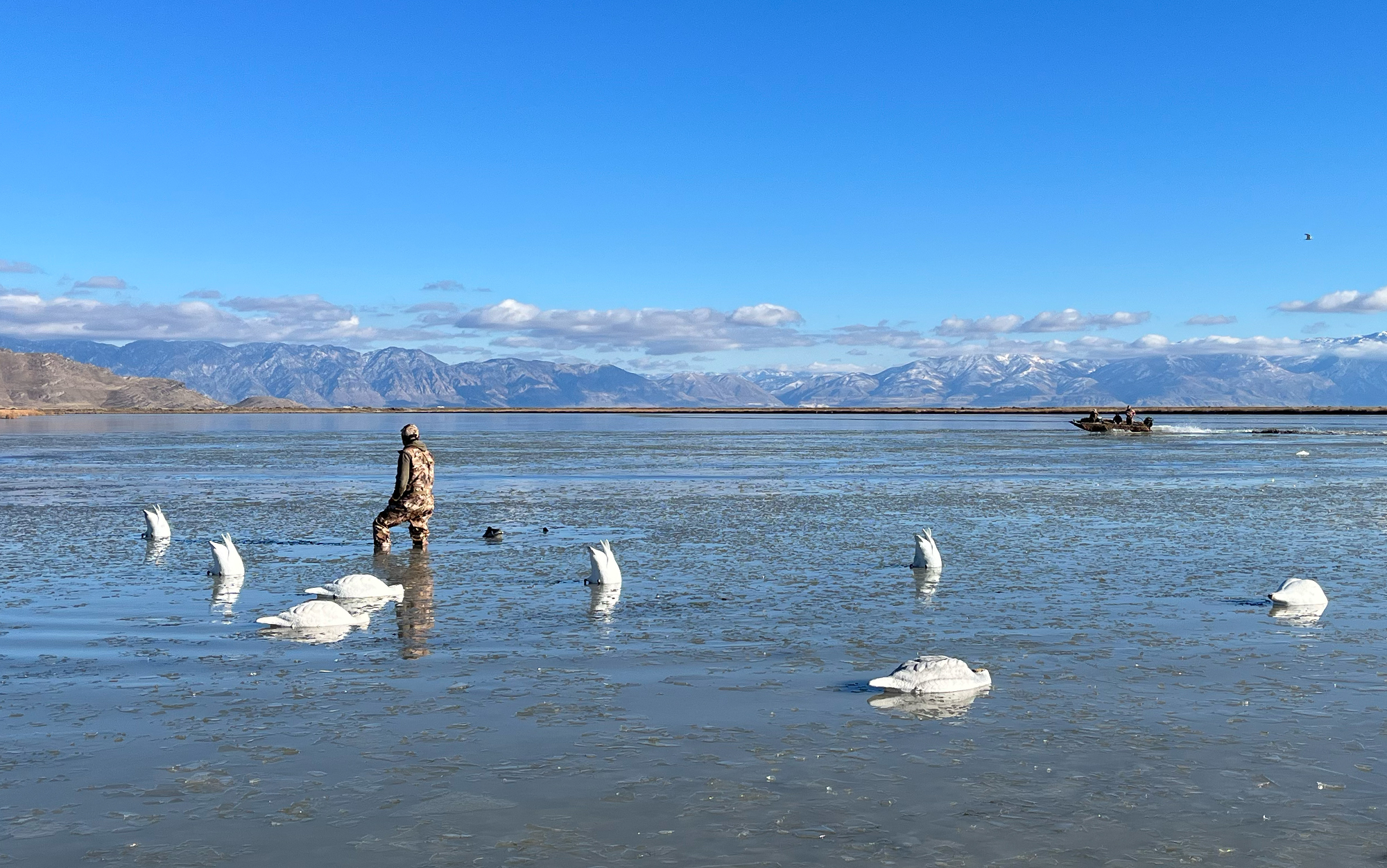
Ashley Thess
A few years ago, I interviewed Chad Yamane, Ducks Unlimited’s regional director of Utah, for a story on the challenges and local legislation of swan hunting. When my buddy didn’t draw his own tag, I reached out to Yamane to ask if he’d still consider taking me under his wing that season. Yamane is a Utah local who’s been hunting swans for nearly 25 years. He started hunting when the strategy was to set spreads of white garbage bags and call swans by shouting “woo!”
He agreed to take me out, and we met on public land hunting land situated near protected waterfowl migration ponds.
In between handfuls of Muddy Buddies Chex mix, Yamane told me how the swans will hang out on refuges all day to avoid hunters. But, soon enough the birds eat all of the food in the small protected area and have to go searching for more. If left unpressured, the birds will decimate the food sources for the entire area over a season. Yamane said that’s why hunters are necessary to move them along.
Armed with more information on the conservation goals behind swan hunting, I felt pretty strongly about killing a tundra. The birds wait until the afternoon to finally leave the protected waters, and that’s the best time to target them.
Most hunters walk the dikes bordering these waters and hope that the swans will fly low enough for pass-shooting. But Yamane has accumulated an impressive spread of swan decoys and a unique talent for mimicking their high-pitched ooo-ing flight call.
Gone with the Wind
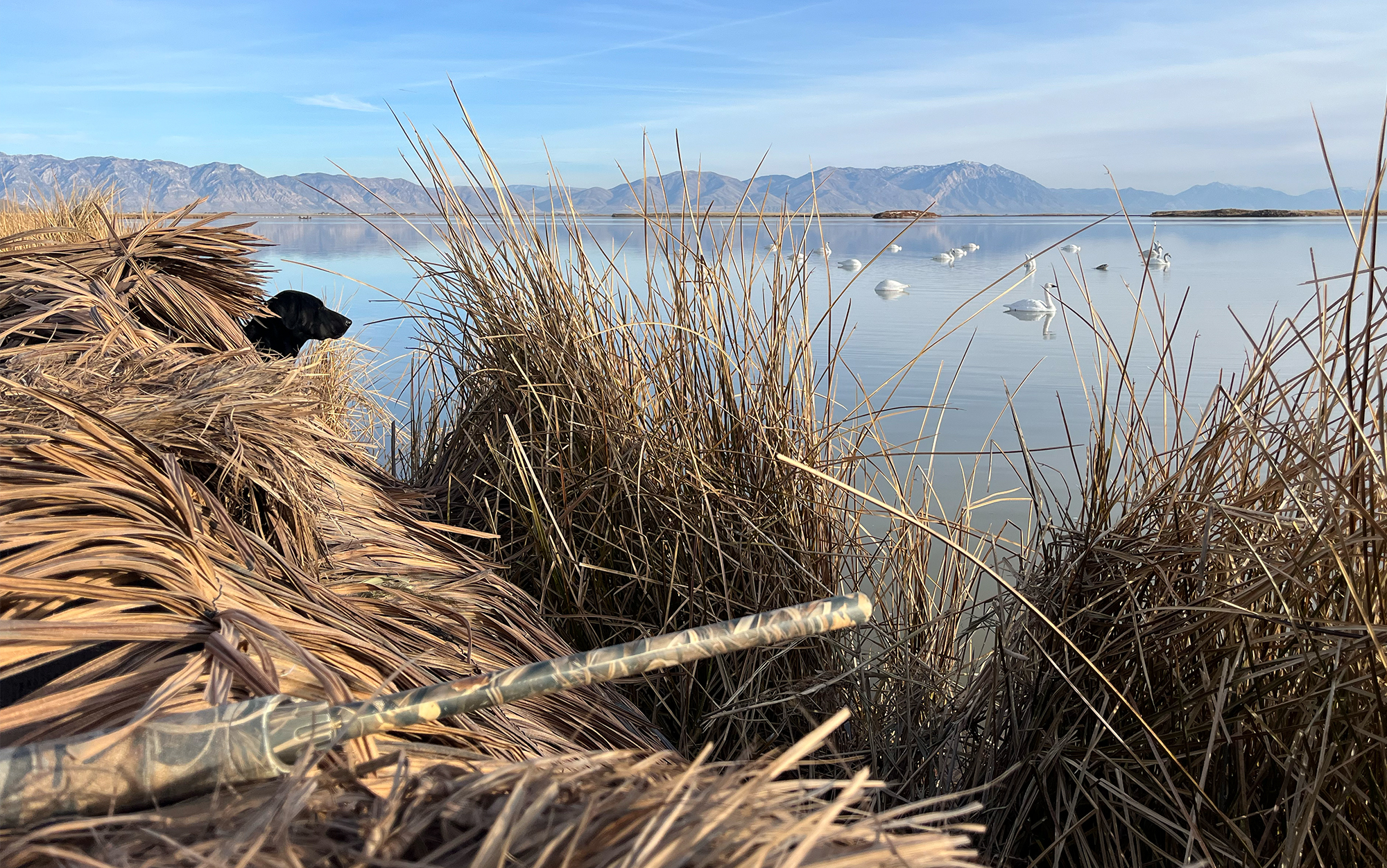
Ashley Thess
The sun started to set; Yamane, Harley (his trusty black Lab), and I hid in the boat blind, along with half a dozen other boats scattered around the tiny wetland. Then, the birds started to fly. Yamane gave me some pointers: Look at the head, and lead the bird. Because they’re so large, tundra swans tend to look like they’re moving slower than they are. But they have about a 5-foot wingspan and one flap of those giant wings will put them out in front of your pellets.
Clearly the other hunters in the area didn’t have a veteran swan hunter whispering tips in their ears, because they shot at high birds and elicited more expletives from Yamane than birds hitting the water. To be fair, I didn’t get a shot off either. Instead I learned that no wind means the birds can fly as high as they want, far away from us hunters on the water below.
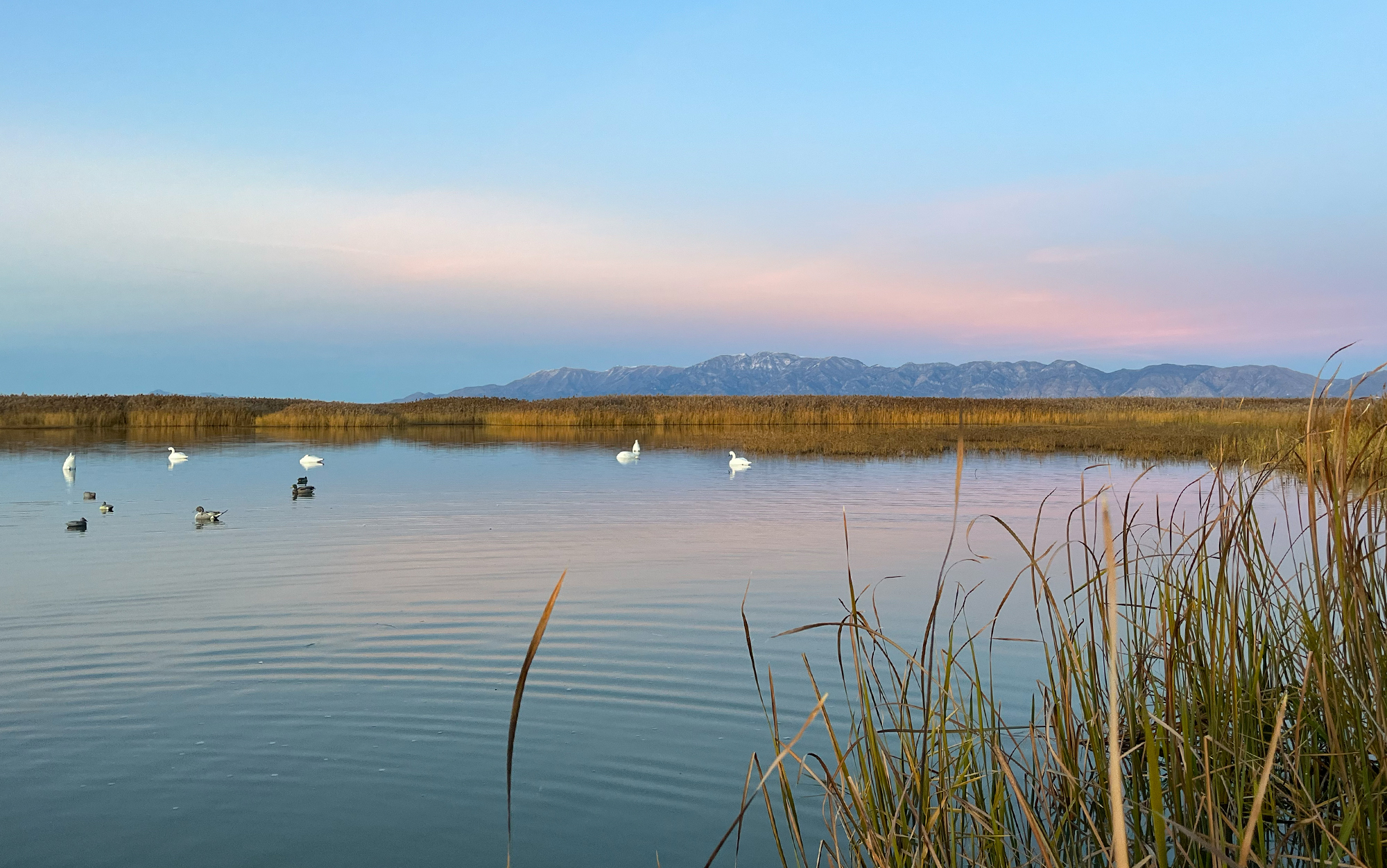
Ashley Thess
The swans were gone with the wind, but I was totally hooked. Hundreds of incredibly giant yet balletic birds belted across the sunset, and I had a front row seat. I was absolutely jazzed for my hour and a half long drive back to Salt Lake City, and I started to understand why hunters target these birds. Originally, I didn’t understand the satisfaction in killing something beautiful, but I definitely wanted to capture the magic of those giant birds.
Riding in Style
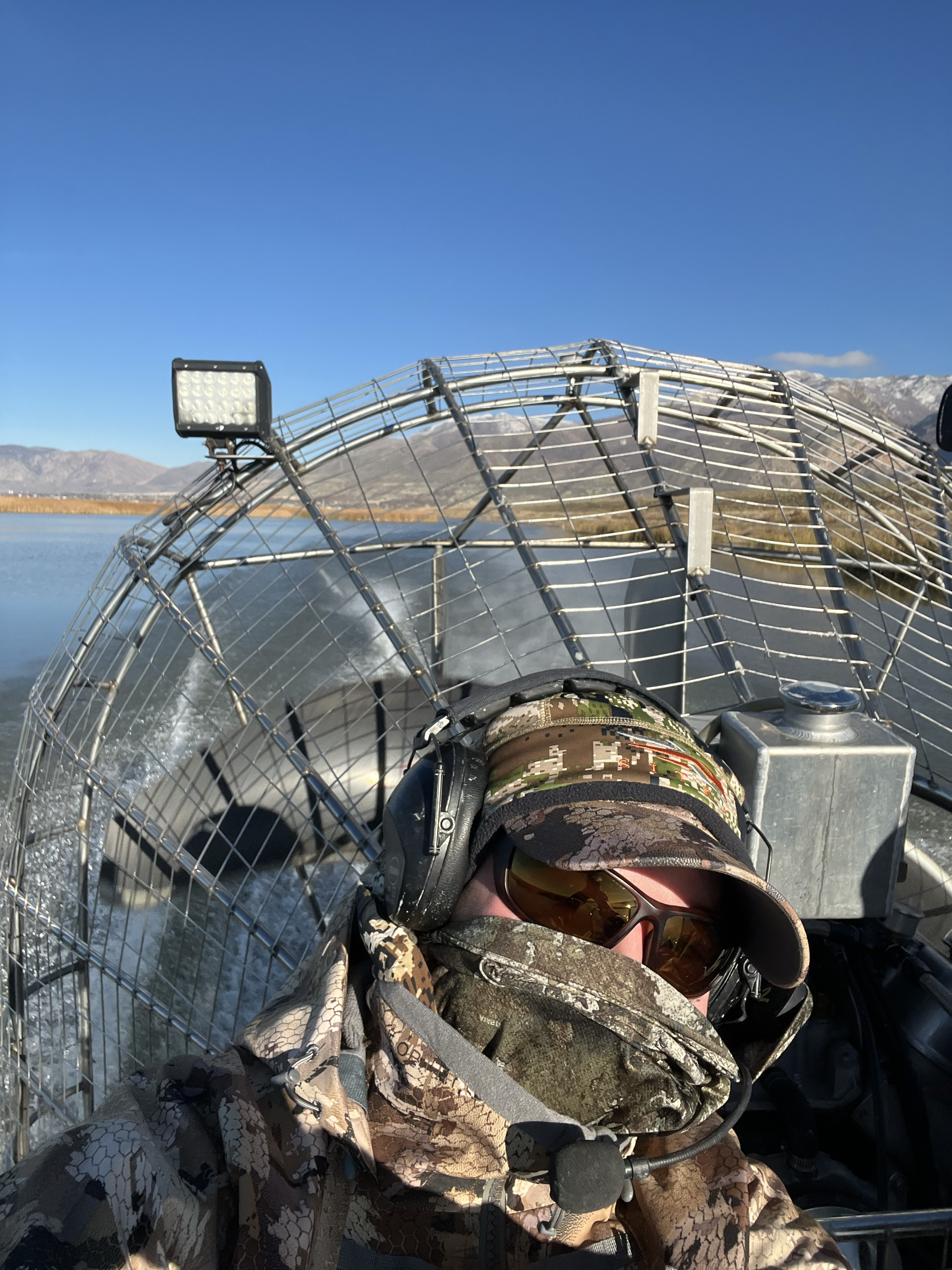
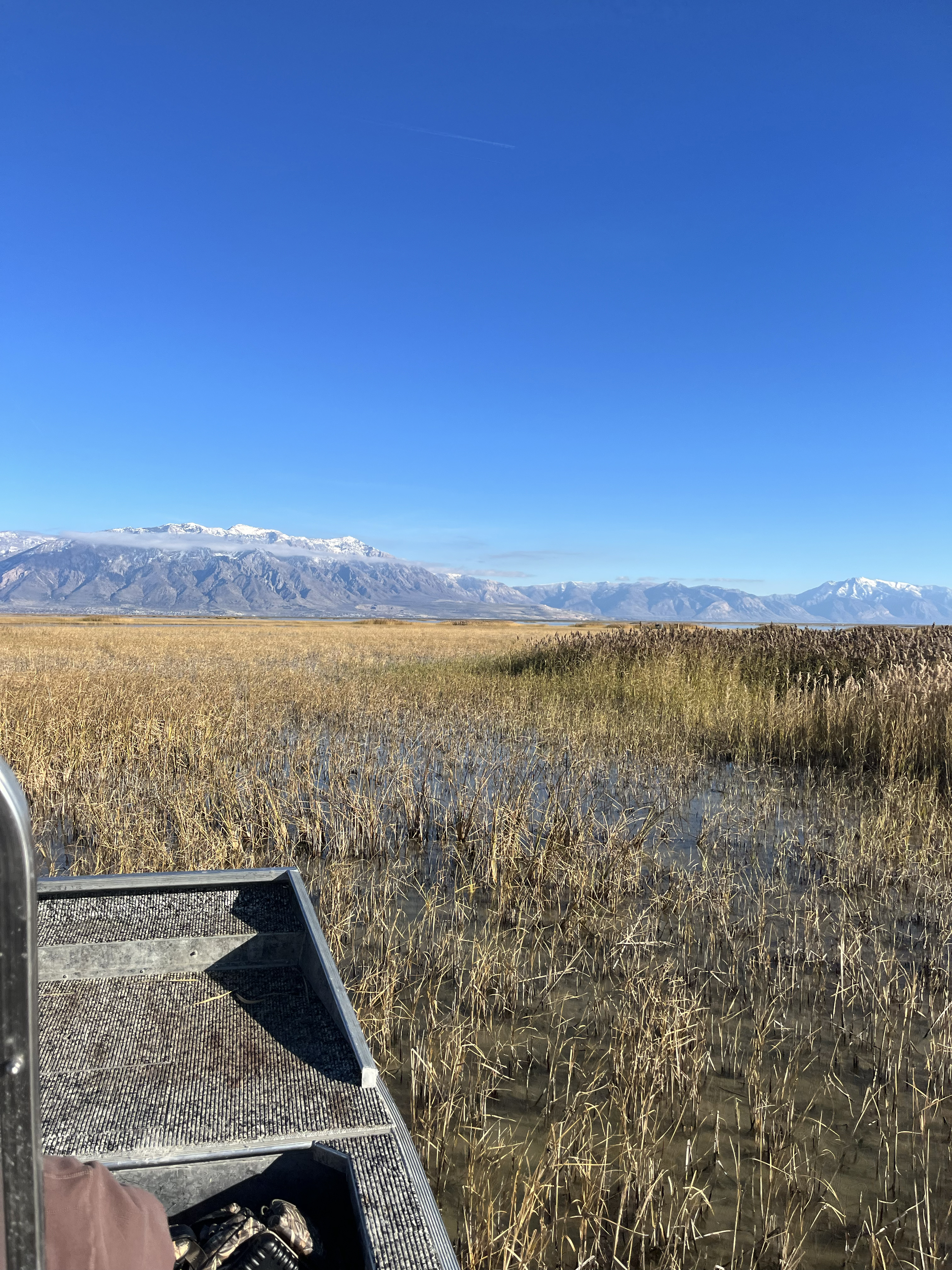
Turns out, the stoke from my first sit hadn’t prepared me for the excitement of the next hunt. To beat the crowds, we went where not many can follow: the now very shallow Great Salt Lake. It’s so shallow in fact, that you have to have an air boat to access some of the best hunting spots. Now, I’ve gone on one of those Florida alligator airboat tours before, but it was nothing like whizzing over inches of glassy water and reeds along the Wasatch Range.
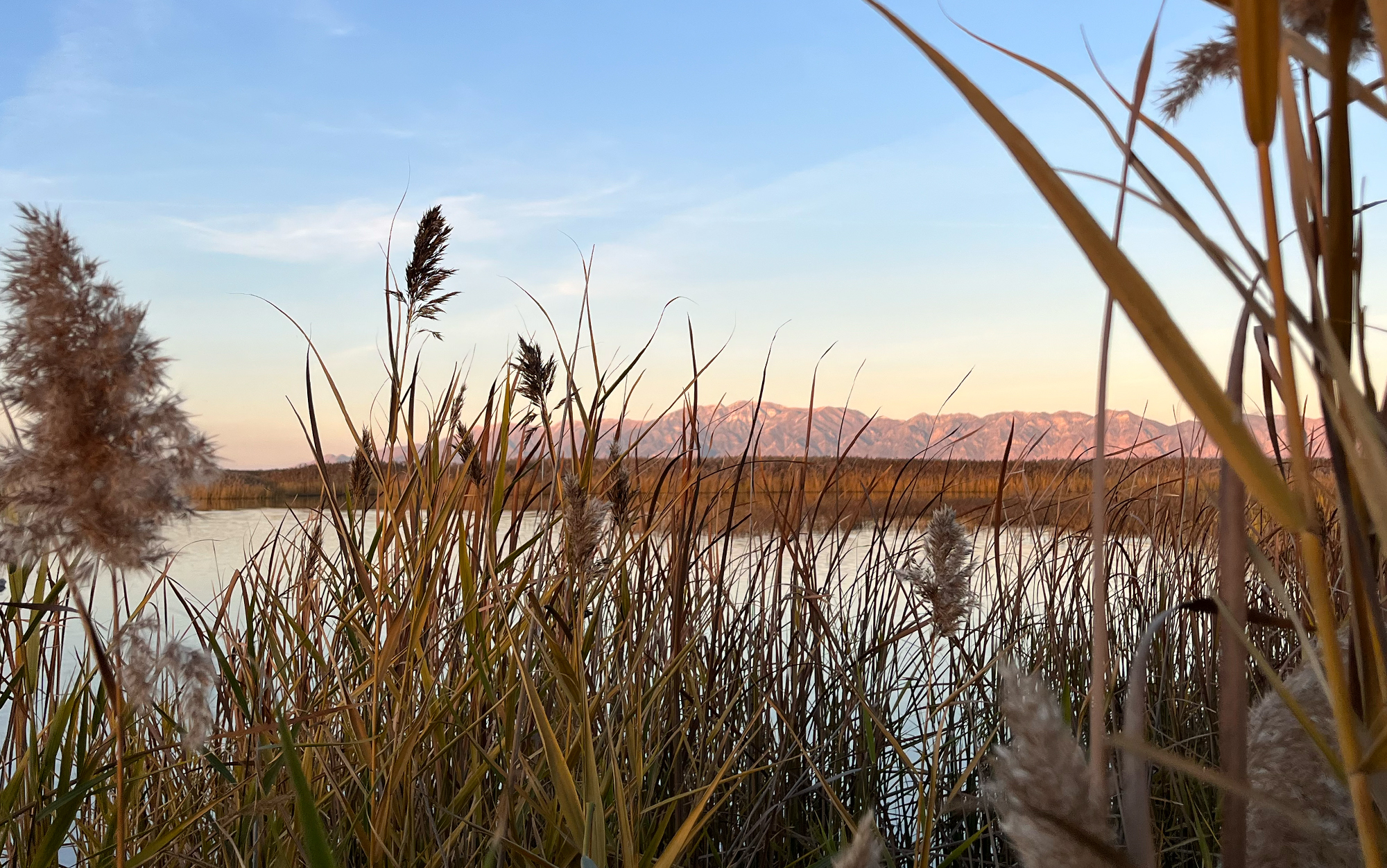
Ashley Thess
Another first-time swan hunter and DU volunteer, John, accompanied us into the invasive bushy-topped reeds. We stood on short platforms to keep out of the mud and I gazed over at the snow capped mountains through the phragmites. The decoys were littered about a large clearing with plenty of landing zones. Tundra swans are big, and they need correspondingly sizable spots to land.
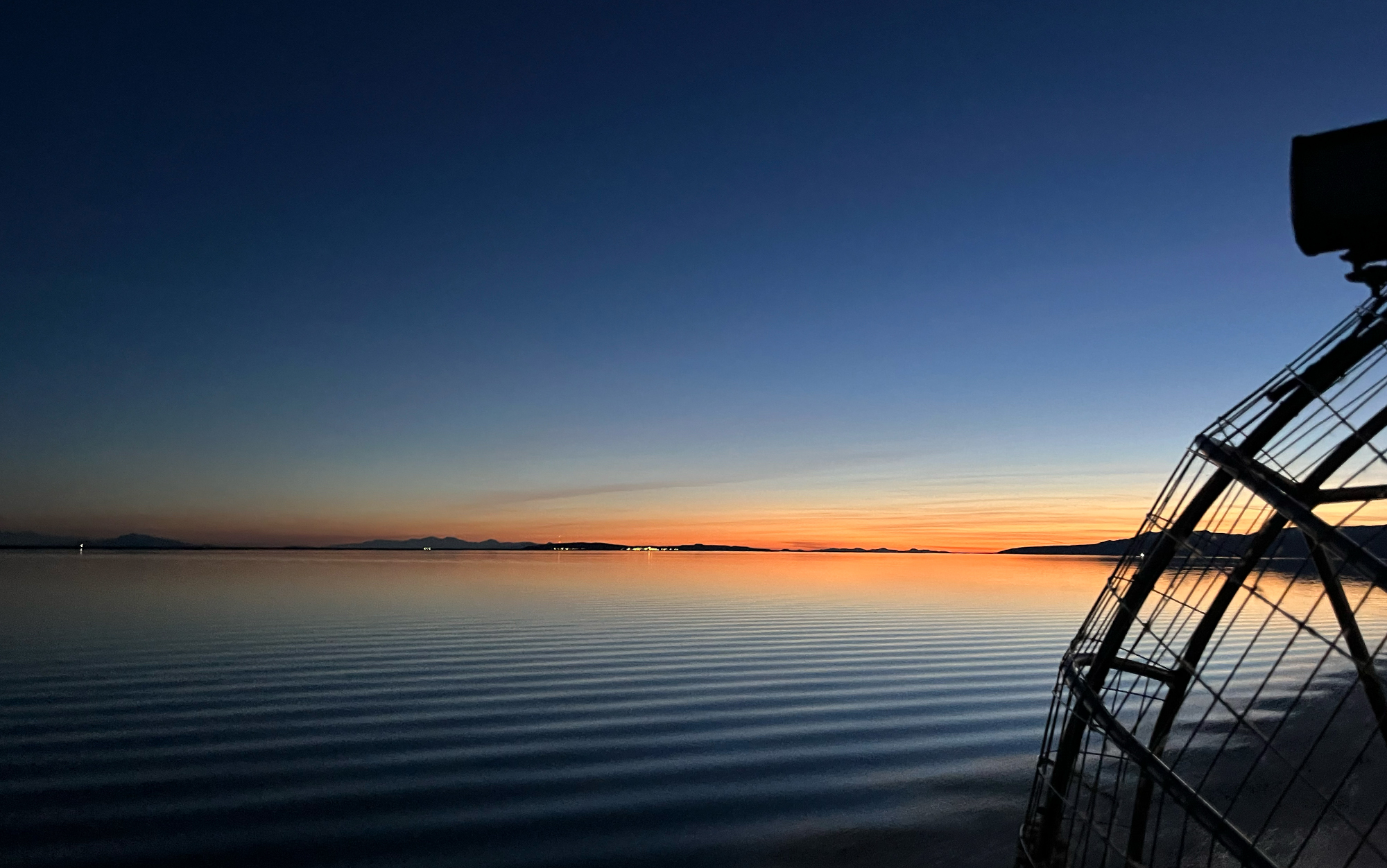
First, we heard the ooo-ou’s. Yamane wooed back. Three swans flew low enough for a shot and with Yamane’s direction, I pulled the trigger on the front bird. I missed entirely, not leading the bird enough. The two others tailed behind where John was at the ready. One of the tailing birds veered away and the others fled. We fired again, but now it was out of range. It flew off, unscathed.
Only Here For the Food
Tundras are incredibly strong animals, hailing from the Arctic. They migrate from the northern reaches of Alaska and Canada down the Pacific Flyway in incredible numbers: Approximately 80,000 fly through Utah every year. I recently spoke to Jason Jones, Utah DNR’s migratory bird coordinator, about the inception of the season.
The hunting season for tundra swans started in 1962 here in Utah. Not because big bad hunters wanted to shoot the biggest, prettiest birds they could, but because of a plant: sago pondweed.
Native to Utah, sago pondweed is an aquatic grass that thrives in clear, moving water. It abounds in the controlled levee system on the northeastern side of the Great Salt Lake where waterfowl congregate on wildlife management areas. Swans love to stop and munch on this plant and, left to their own devices, they will eat themselves out of house and home. This is particularly true given vanishing wetland habitat as more of the desert state is developed by humans.
If the sago pondweed is decimated on the Southern migration, there’s nothing left for them, or other waterfowl, to eat on the spring migration. Utah distributes more swan tags than other states in the Pacific Flyway to combat this issue. Hunters are afforded the opportunity to target one of the largest flying birds in North America, and they pressure the swans enough to move along and leave some pondweed for other waterfowl, like ducks.
Breaking the Ice
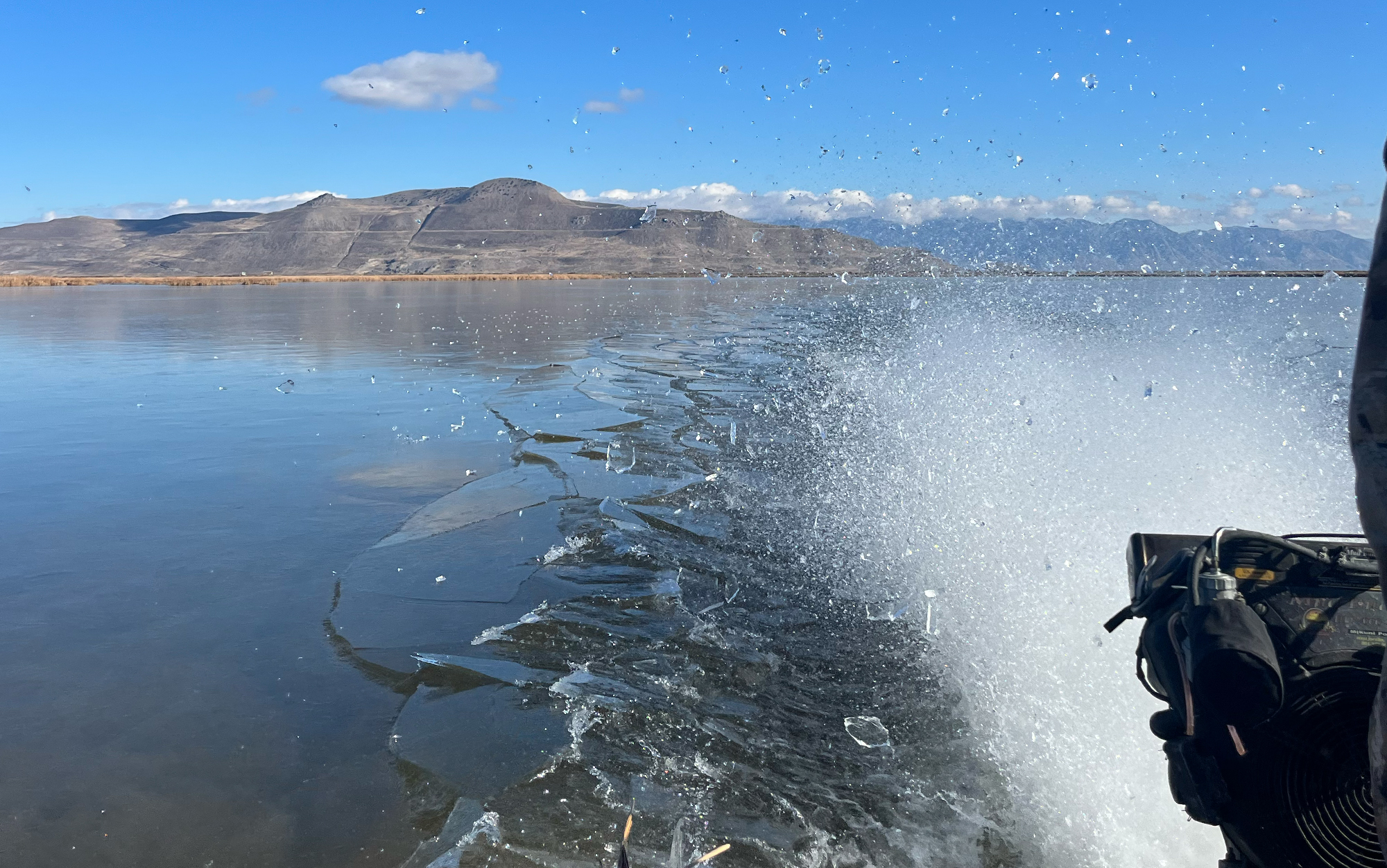
Ashley Thess
With only 10 days left in the season, I was determined to shoot a swan. By late November, the WMA waters had iced over. So the first thing to do after we launched was break it up and create open water for swans to land. This involved a joy ride across the wetland in Yamane’s boat as chunks of ice flew into the air and Harley huddled close to me for warmth.
Another hunting party joined us in our donuts to break up half the marsh. We parked close enough that our decoys formed one giant spread. But after two hours, the broken ice began to drift into the decoys — causing Yamane to grumble ominously to himself. Eventually he jumped in and strode through mud and ice hunks to break up what he could. Once back in the boat, he said we could hold out for some breeze to push the ice away. We waited, and the ice situation didn’t improve, but it didn’t worsen, either.
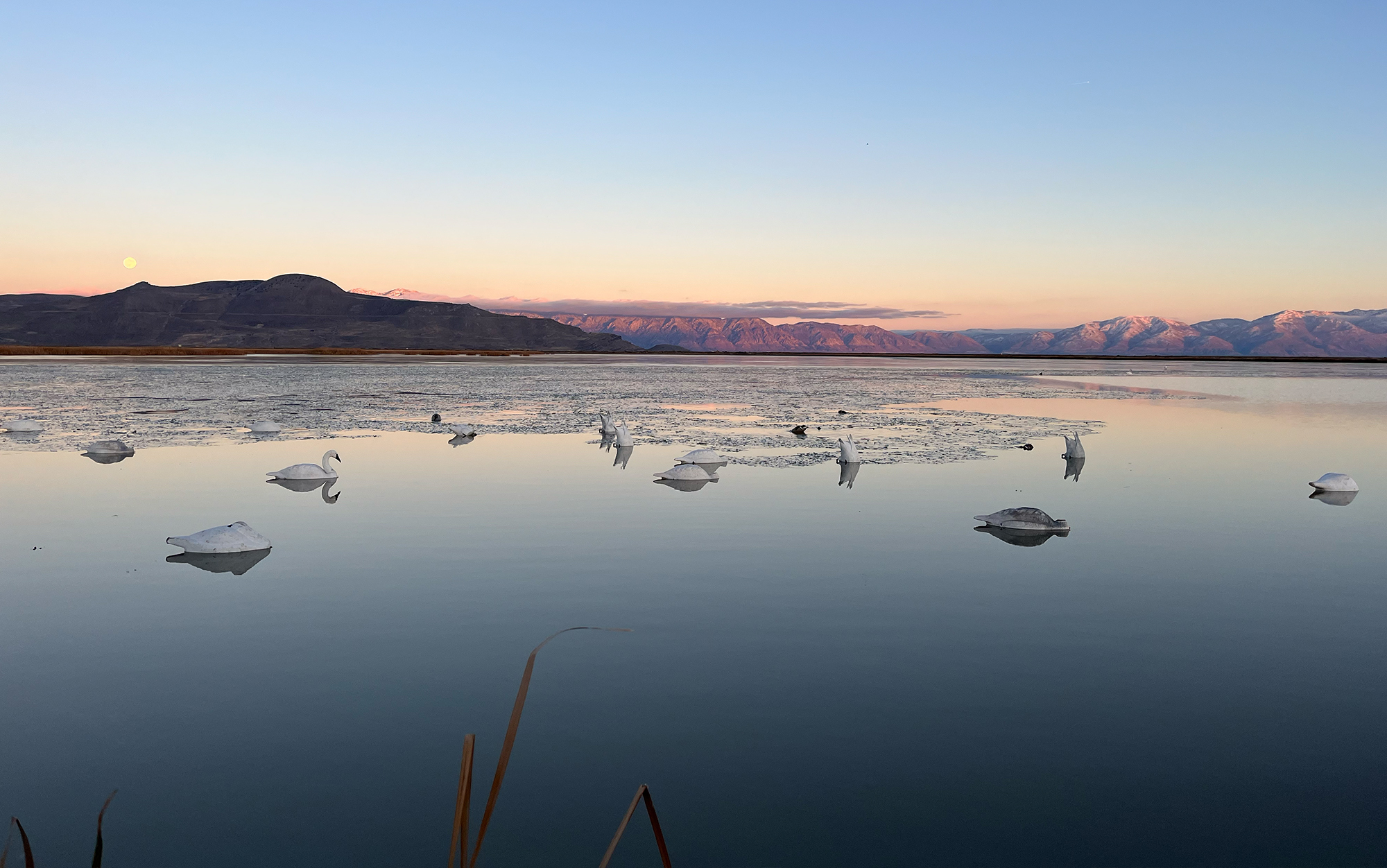
Ashley Thess
Eventually the sky developed a cotton-candy hue and a full moon rose up over the hills for a breathtaking view. With 10 minutes left of shooting light, and no feeling in my fingers, I willed a swan to appear.
Then, a pair flew overhead and Yamane diligently called to them. They swooped in front of us, and we fired as they leapfrogged each other over our spread in an attempt to escape. Both sailed past us and crashed down into the water on the other side of the decoys.
“That solves the mating for life problem,” Yamane said. “Just shoot ‘em both!”
Home Run
But there wasn’t much time for celebrating. I shook in chills and disbelief as I nervously watched our swans flop much further away than I’d thought possible. But with two precious minutes of shooting light left, we had to stay hid for the other boat. Content with my own success, I thought there was no way we’d see more birds in such a short time after firing off so many shots.
But two more tundras descended and the other boat dropped them both. We hurriedly dismantled our blind and took off after our two downed tundras that were paddling to opposite ends of the wetland. In a testament to their toughness, Yamane and I both jumped in the water in order to corral one of the swans to the boat. With shooting light over, we didn’t want to fire off another shot. Eventually, we pulled it in.
Yamane said that Swan belonged to John, the other new swan hunter. We motored off to collect mine, which was nearly finished when we reached it. By the time we scooped it into the boat, all three of us were grinning.
The Harvest
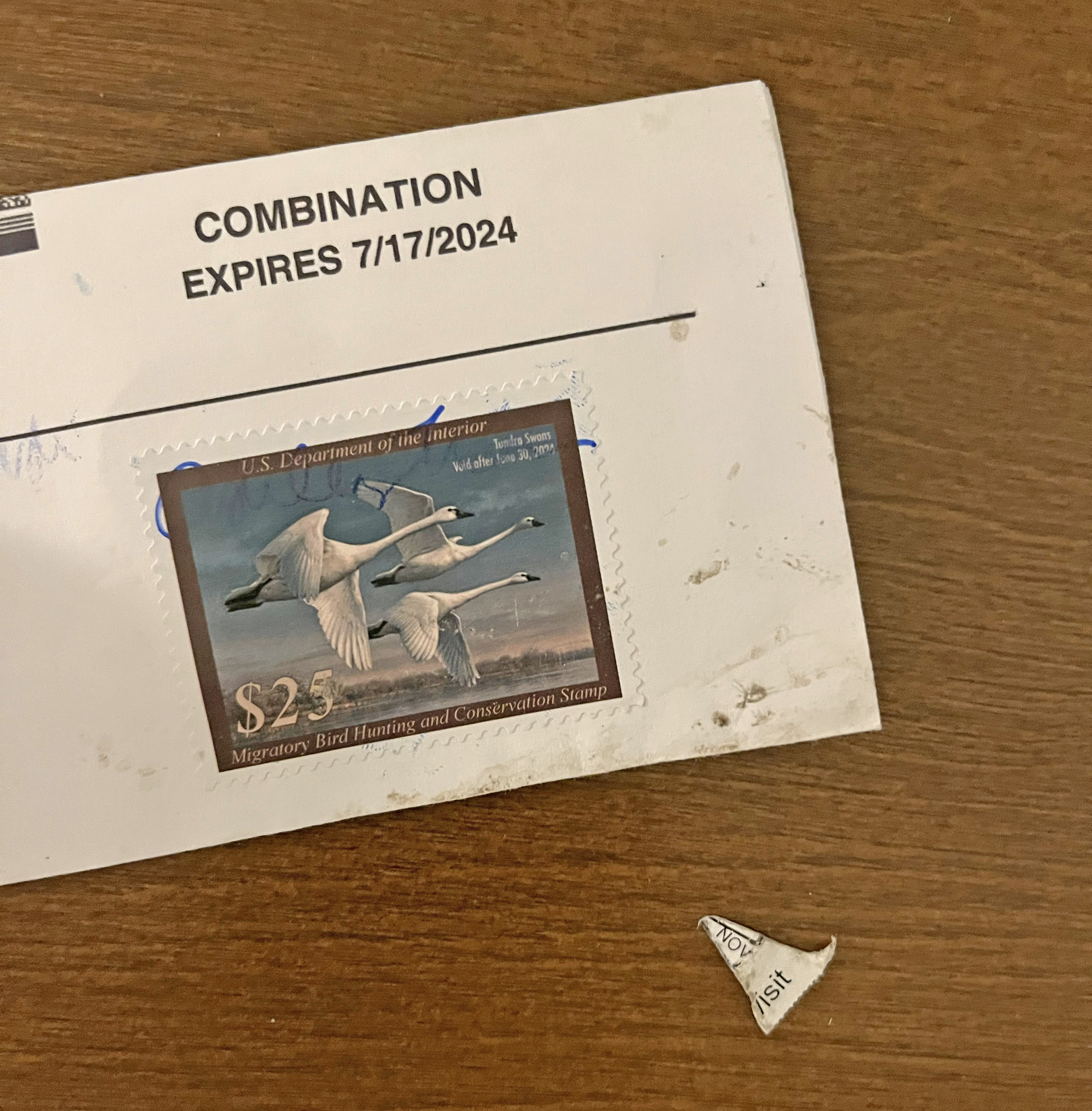
Ashley Thess
In Utah you must bring your swan to a check station to verify it’s a tundra swan (it’s illegal to shoot trumpeter swans in Utah). I took my harvested bird into the DNR the following day, but after that, I was stumped on what to do. I live in a one-bedroom apartment in downtown Salt Lake. What was I supposed to do with a giant swan carcass?
I planned to at least try swan meat, so I hemmed and hawed about whether I could efficiently butcher a bird in my bathtub. After some research, I decided to keep the fat on one breast, which meant I’d have to pluck it. Everything I found on the internet says, under no circumstances, should you pluck a bird indoors. Apparently down feathers are harder to get rid of than glitter.
So I set up shop on top of a cooler on my front porch for anyone and God to see. I’m thankful my neighbors didn’t come home. Classify butchering a swan on your urban porch under things that feel illegal, but probably aren’t.
Myth Busted
First, I tried making swan jerky. It was fine, drying to a decent consistency. It tasted like Worcestershire sauce from the brine and not much else, which wasn’t bad.
The second attempt was the real test. I opted for a fancy sounding duck recipe I found online that used a miso glaze topped with balsamic peaches. After marinating the swan meat in miso paste, soy sauce, ginger, orange juice, and spices, I browned it in an Instant Pot and let it pressure cook. I served it with white rice and roasted brussel sprouts, and … damn, was it tasty. Consider the myth that swans are inedible busted.
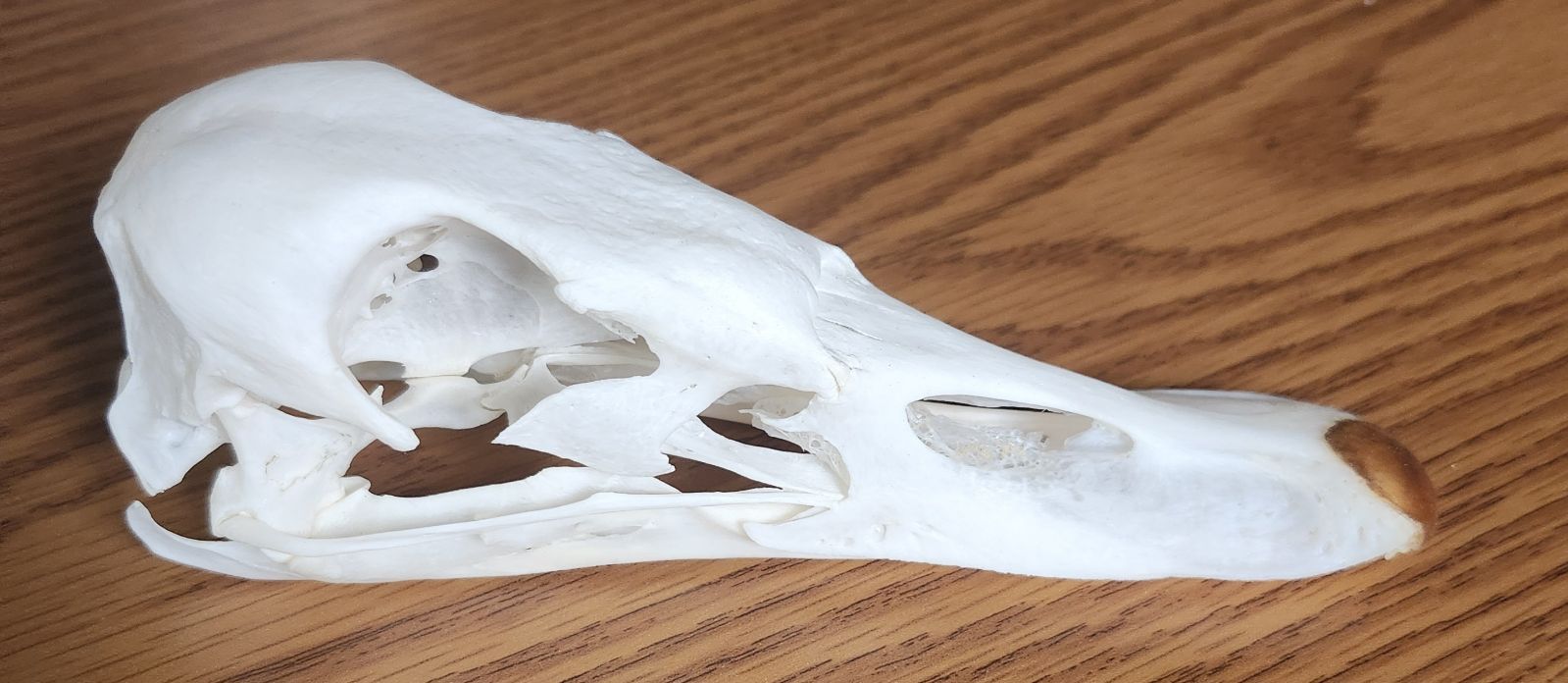
Ashley Thess
Swan hunting was an adventure unlike any other hunting I’ve experienced. It was wild and picturesque. I was able to take in some incredible nature, and got to witness some spectacularly interesting and tough birds on their migration south. While there are plenty of good reasons to hunt swans, like conservation, conversation-starting home decor, and good eats, to me the best reason is the simplest: It’s wicked fun.
The post Why Hunt Swans? Among Other Reasons, It’s Wicked Fun appeared first on Outdoor Life.




